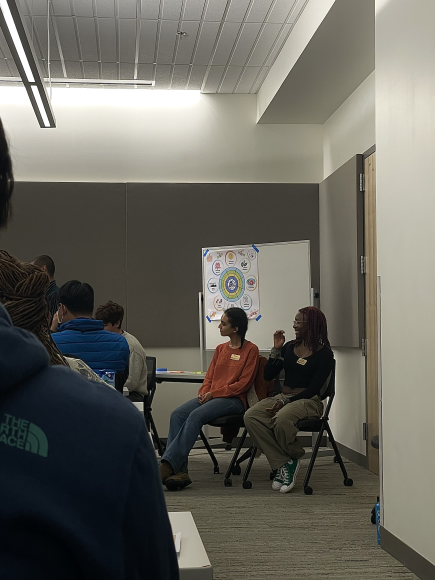
The Climate Justice Team listens closely to the panelists during “Healing and Action” discussion in CU Boulder’s CASE Building, Thursday, Nov. 10 (Lauren Schaffler/CU Independent)
Recently, mental health on college campuses is becoming an important matter for academic faculty to consider. Acknowledging that every student’s struggle is different, student and faculty-led organizations are offering inclusive events about many different topics for those looking for support.
On Thursday, Nov. 10, the Climate Justice Team at the University of Colorado Boulder’s Environmental Center hosted a panel discussion titled “Healing and Action,” featuring experts in cultural and indigenous practices. The event included Natalie Avalos, an assistant professor of Native American and Indigenous Studies at CU Boulder; Adriana Paola Palacios Luna, the founder of Luna Cultura; and Ian Sanderson, a member of the Mohawk Nation and a professor at Naropa University. The discussion focused on social justice and finding community on college campuses through the lens of indigenous cultures.
The event began with a group dinner, provided by the Climate Justice Team. After the dinner, CU Boulder student Lucas Batista invited everyone to stand and do a few light stretches, to take a few moments for self-care before the discussion began.
Sanderson led the discussion, talking about the lack of acknowledgment of indigenous cultures, referring to the centuries of colonialism worldwide that didn’t respect previous indigenous land ownership.
“We’ve been kind of made to be invisible — not just in North America but around the world,” Sanderson said.
Sanderson has worked in the field of outdoor and experiential education for 15 years, devoting his time to educating those who are interested in empowerment and personal development through philosophies found in indigenous and Eastern traditions. Along with this philosophical work, he is involved in organizations such as Canadian Outward Bound Wilderness School, the Santa Fe Mountain Center’s Native American Emergence Program, the Denver Indian Center and the Environmental Center at CU Boulder. He is working to reconnect communities to the natural world in an inclusive way.
During the discussion, Sanderson asked the audience to envision what the CU Boulder campus might have looked like before technology, when it was an empty valley.
“I was told that this was a particularly special place,” Sanderson said. “Even if there was conflict between nations, it would get suspended because those areas were sacred.”
By introducing this idea, Sanderson offered a more open-minded perspective of peace and healing through working together toward the same goal.
This led into the next concept: how community is one of the main focal points within indigenous practices. This creates space to broaden relationship skills and make connections.
“It is very important to acknowledge how we share, whether it be when we are together, in a relationship or in our community,” Luna said.
For 28 years, Luna has worked on socio-environmental justice and social change projects, where she researches better means of communication for social change, culture, gender equity, identity and human rights.
Following Luna’s answer, Avalos talked about a study that showed how interacting with others and communicating about past trauma can reduce the stress of social situations. This research can be applied to indigenous cultures who are still practicing in biodiverse areas of the planet. Having a community that follows the same practices and traditions will help to reduce the feeling of psychological and psychosocial stress.
“When others are suffering from acts of violence, shifting and expanding a worldview and paradigm helps people out of whatever they’re coming in with,” Avalos said.
Later, Sanderson offered a personal anecdote, talking about his experience working with a community that didn’t understand certain Native American traditions and viewed him only through the lens of his identity.
Avalos expanded on this idea, saying, “That is the main form of racialization that indigenous cultures experience today, especially the younger generations are more tapped into this feeling.”
“That is what colonialism has done,” Avalos said. “It has estranged us from one another, objectifying and racializing some people over others.”
In response to these experiences, many indigenous people may find themselves disassociating, according to Avalos.
“We might find ourselves just feeling depressed or hopeless,” he said. “But having conversations like this and being in a community of others that care and are invested applies to us socially as humans.”
Through this panel, CU’s Environment Center is trying to facilitate this type of conversation and to start a dialogue between students, faculty and local indigenous members.
“Caring work should be more equitable,” Luna said. “There is value in everybody who is actually doing it.”
Contact CU Independent Assistant Arts and Editor Lauren Schaffler at lauren.schaffler@colorado.edu.
